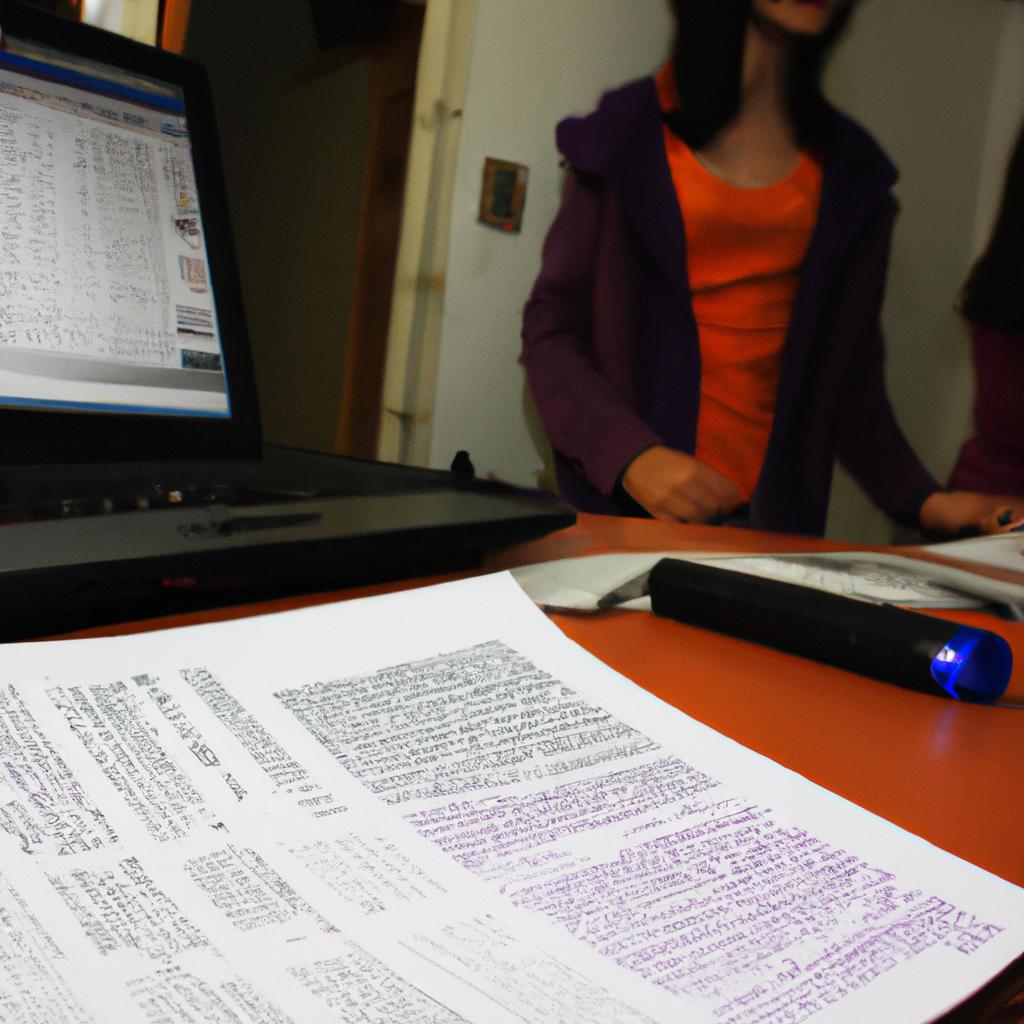Script Analysis for Actresses: The Art of Theater Performance

The art of theater performance requires actors and actresses to not only embody their characters but also bring them to life on stage. One crucial aspect of this process is script analysis, which allows performers to delve deep into the text, understand its nuances, and make informed choices about character development and interpretation. In this article, we will explore the importance of script analysis specifically for actresses and how it enhances their ability to fully immerse themselves in their roles.
To illustrate the significance of script analysis in guiding an actress’s performance, let us consider a hypothetical scenario. Imagine a play where the protagonist is a complex woman torn between societal expectations and her own desires. Without proper script analysis, an actress may struggle to capture the multidimensionality of such a character accurately. However, by meticulously studying the dialogue, subtext, and stage directions provided in the script, she can gain valuable insights into her character’s motivations, conflicts, and relationships with other individuals within the story. This knowledge enables her to portray a more authentic representation of her role while effectively conveying the emotional depth required for a compelling theatrical experience.
Script analysis empowers actresses with tools that allow them to craft well-rounded performances with depth and authenticity. By examining key elements such as plot structure, thematic motifs, characterization techniques , and dramatic beats, actresses can gain a deeper understanding of the overall story arc and how their character fits into it. They can identify moments of conflict, tension, and emotional growth that are crucial for creating engaging performances. Script analysis also helps actresses to uncover the subtext within the dialogue, which allows them to convey underlying emotions and intentions that may not be explicitly stated.
Furthermore, script analysis assists actresses in developing a strong character backstory. By exploring their character’s past experiences, relationships, and personal history, actresses can make informed choices about how their character would behave and react in different situations. This level of preparation adds layers of complexity to their performance and gives them a solid foundation from which to build upon during rehearsals.
In addition to enhancing character development, script analysis aids actresses in understanding the dynamics between characters. By closely examining interactions with other characters, actresses can discern power dynamics, conflicts, alliances, or even hidden agendas. This knowledge informs their choices on stage and enables them to create believable relationships that contribute to the overall narrative.
Moreover, script analysis helps actresses understand the broader themes and messages within the play. By identifying recurring motifs or symbols throughout the text, they can align their performance with the playwright’s intended vision. This alignment allows them to effectively communicate these themes to audiences through their portrayal of the character.
Overall, script analysis is an indispensable tool for actresses in preparing for a theatrical performance. It equips them with a deep understanding of their character’s motivations, relationships, emotional journey,and thematic significance within the play. Armed with this knowledge and insight gained through careful examination of the script, actresses can bring their characters to life on stage in a nuanced and authentic manner that captivates audiences and contributes to a powerful theatrical experience.
Understanding the Script
Understanding the Script
The script serves as a blueprint for theater performances, providing actors with the necessary framework to bring characters and stories to life on stage. Actresses must possess a deep understanding of the script in order to effectively portray their roles and engage audiences. By analyzing various elements within the script, actresses can uncover hidden nuances, motivations, and relationships that contribute to a more authentic performance.
To illustrate this point, let us consider an example: a play centered around two sisters who have grown apart due to their conflicting aspirations. Through careful analysis of the script, an actress can gain insights into each character’s desires, fears, and emotional journey throughout the narrative. This knowledge allows her to make informed choices regarding characterization, physicality, and vocal expression that align with the playwright’s intentions.
In delving into script analysis, there are several key aspects that deserve attention:
- Dialogue: Paying close attention to dialogue helps actresses grasp not only what is explicitly said by characters but also what remains unsaid or implied between them. These subtleties shape the dynamics between characters and influence how they interact onstage.
- Themes: Identifying recurring themes or motifs within the script enables actresses to explore deeper layers of meaning beyond surface-level storytelling. Themes often evoke emotions such as love, loss, betrayal, or redemption which resonate with both performers and audience members alike.
- Structure: Understanding the structure of the script provides insight into pacing, climactic moments, and overall dramatic arc. Recognizing these structural components empowers actresses to navigate through different stages of tension and resolution effectively.
- Historical Context: Considering the historical context surrounding a play enhances an actress’s comprehension of its social relevance and cultural significance. It allows her to connect with the period-specific circumstances influencing her character’s mindset and actions.
By engaging in thorough script analysis encompassing these facets (as illustrated above), actresses can develop a comprehensive understanding that goes well beyond simply memorizing lines. This in-depth exploration equips them to embody their characters with authenticity, relatability, and emotional depth.
Transitioning seamlessly into character analysis, actresses can further apply their script understanding to delve deeper into the intricacies of their roles. Through this process, they uncover the nuances of their characters’ personalities, relationships, and motivations, all essential elements for a compelling theatrical performance.
Character Analysis
Transitioning from the previous section on understanding the script, we now delve into character analysis. This crucial step allows actresses to fully comprehend and embody the personas they will bring to life on stage. To illustrate this process, let us consider a hypothetical example involving an actress preparing for the role of Lady Macbeth in Shakespeare’s tragedy “Macbeth.”
Character Analysis:
In order to portray Lady Macbeth effectively, an actress must conduct a thorough character analysis. Firstly, it is essential to understand her background and motivations. Lady Macbeth is depicted as ambitious and power-hungry; she plays a significant role in driving her husband towards regicide. By examining her desires and fears, the actress can uncover the underlying complexities that shape her actions throughout the play.
Additionally, exploring Lady Macbeth’s relationships with other characters provides valuable insight into her personality. For instance, analyzing her interactions with Macbeth reveals their shared ambition and how it manifests within their partnership. Understanding these dynamics helps the actress establish believable connections during performances.
Furthermore, through textual analysis, specific traits emerge that are vital to portraying Lady Macbeth convincingly. These may include her manipulative nature or vulnerability masked by a façade of strength. Utilizing techniques such as close reading and subtextual interpretation enables actresses to grasp subtle nuances embedded within the text.
To evoke an emotional response from audiences while discussing character analysis:
- Uncover hidden depths
- Explore complex relationships
- Portray intricate emotions
- Confront inner conflicts head-on
The following table showcases how various elements intertwine in character analysis:
| Aspect | Importance | Examples |
|---|---|---|
| Background | Provides context | Childhood experiences |
| Motivations | Drives actions | Desire for power |
| Relationships | Influences behavior | Interactions with Macbeth |
| Key Traits | Defines character | Manipulative nature |
Consequently, by conducting a comprehensive character analysis, actresses can bring authenticity and depth to their performances. This understanding serves as the foundation upon which they build their interpretations of complex roles.
Transitioning from character analysis, we now move on to exploring motivation and objectives in the next section. By examining these aspects, actors gain further insight into their characters’ intentions and actions without explicitly labeling it as another step in the process.
Motivation and Objectives
Having explored the intricacies of character analysis, we now turn our attention to another essential aspect of script analysis for actresses: motivation and objectives. Understanding the motivations and objectives of a character is crucial in bringing depth and authenticity to theater performances. Let us delve into this topic further.
Motivation refers to the driving force behind a character’s actions or behavior. It provides insight into why a character behaves in a certain way and helps actors make more informed choices during their performance. For instance, consider the case study of Sarah, a young actress preparing for the role of Ophelia in Shakespeare’s “Hamlet.” By analyzing Ophelia’s motivations, such as her desire for love and approval from her father Polonius, Sarah gains valuable insights into how to portray the character convincingly on stage.
Objectives are closely related to motivation but focus on specific goals that characters strive to achieve within a scene or throughout the play. Objectives provide actors with tangible targets they can work towards and help create dynamic interactions between characters onstage. To illustrate, let us examine four common types of objectives found in theatrical scripts:
- Survival: Characters may have an objective centered around self-preservation or escaping dangerous situations.
- Power/Control: Some characters seek authority or dominance over others, influencing events according to their desires.
- Love/Affection: Many characters pursue romantic relationships or long for emotional connection with others.
- Justice/Revenge: In certain plays, characters might be motivated by seeking retribution for perceived wrongs done against them.
To better visualize these concepts, we present below a table summarizing different motivations and corresponding objectives commonly seen in theater:
| Motivation | Objective |
|---|---|
| Fear | Fleeing danger |
| Ambition | Attaining power |
| Loneliness | Finding companionship |
| Betrayal | Seeking revenge |
Understanding both motivation and objectives allows actresses to tap into the emotional core of their characters, creating a more profound connection with the audience. By delving deep into these aspects during script analysis, performers can bring authenticity and relatability to their portrayal on stage.
As we embark on this emotional journey through script analysis, we will explore how understanding motivations and objectives intertwine with an actress’s exploration of her character’s emotional landscape.
Emotional Journey
Building on the understanding of an actress’s motivation and objectives, we now delve into exploring the emotional journey that unfolds in theater performances. This section examines how actresses navigate their characters’ emotions to create a compelling portrayal.
To illustrate this concept, let us consider the character of Eliza Doolittle from George Bernard Shaw’s “Pygmalion.” Eliza’s transformation from a lower-class flower girl to a refined lady is marked by significant emotional shifts throughout the play. As an actress portraying Eliza, it is crucial to understand her emotional journey and effectively convey these changes to the audience.
One way actresses can approach their characters’ emotional journeys is through careful script analysis. By closely studying the text, they can identify key moments where emotions shift or intensify. These pivotal moments often coincide with major events or revelations in the plot. For instance, when Eliza finally speaks proper English for the first time after intense training, her joy and sense of achievement are palpable on stage.
In order to evoke an emotional response from the audience during performances, actresses employ various techniques:
- Authenticity: Actresses strive to authentically embody their characters’ emotions by drawing from personal experiences or creating believable scenarios.
- Vocal modulation: Through changes in tone, volume, and pace, actresses skillfully express a wide range of emotions such as anger, sadness, joy, or fear.
- Physicality: Utilizing body language and gestures enhances the audience’s connection with the character’s feelings.
- Timing: The timing of emotional reveals or climactic moments plays a crucial role in capturing the attention and empathy of viewers.
By incorporating these techniques into their performances, actresses engage audiences emotionally and deepen their connection with both the character and the story being told.
Transitioning seamlessly into our subsequent section about “Physicality and Movement,” we explore how an actress’s physical presence contributes significantly to conveying emotion without explicitly stating it. Understanding the importance of physicality and movement allows actresses to fully embody their characters, enriching their performances in ways that words alone cannot achieve.
Physicality and Movement
Transitioning smoothly from the previous section on the emotional journey, we now delve into the crucial aspects of interpretation and expression in theater performance. To illustrate this concept, let us consider a hypothetical case study involving an actress preparing for the role of Lady Macbeth in Shakespeare’s “Macbeth.”
When it comes to interpreting a character like Lady Macbeth, an actress must take into account various factors such as historical context, psychological motivations, and textual analysis. By studying these elements thoroughly, she can gain insights into her character’s thoughts, feelings, and actions. In doing so, the actress is able to portray the complexity of Lady Macbeth’s ambition-driven descent into madness.
To effectively express the multifaceted emotions required for a role like Lady Macbeth, actresses employ a range of techniques. Here are some key considerations:
- Vocal modulation: The actress should explore different tones, pitches, and rhythms to convey varying moods and emotions.
- Gestures and body language: Purposeful movements can enhance the portrayal of characters by adding depth to their physical presence on stage.
- Facial expressions: Utilizing facial muscles to reflect inner thoughts and feelings enables audience members to connect with the character at a deeper level.
- Timing and pacing: Employing pauses or altering speech patterns can create dramatic tension or emphasize specific moments within a scene.
Let us further understand how these techniques come together through an example table that showcases different emotional states throughout Lady Macbeth’s arc:
| Emotional State | Vocal Modulation | Gestures & Body Language | Facial Expressions |
|---|---|---|---|
| Ambition | Firm tone | Assertive hand gestures | Determined gaze |
| Guilt | Trembling voice | Wrings hands nervously | Pained expression |
| Desperation | Frantic pace | Clutches chest dramatically | Wild-eyed, almost hysterical |
In conclusion, the art of interpretation and expression in theater performance demands careful analysis and skilled execution. By immersing themselves in the text and employing various techniques such as vocal modulation, gestures and body language, facial expressions, and timing, actresses can bring characters to life on stage.
Transitioning seamlessly into our next section on ‘Interpretation and Expression,’ we explore how an actress’s physicality and movement contribute to a captivating theatrical experience.
Interpretation and Expression
Section H2: Interpretation and Expression
Transitioning from the previous section on Physicality and Movement, where an actress explores the ways in which her body can communicate meaning to an audience, we now delve into the realm of interpretation and expression. While physicality sets the stage for a captivating performance, it is through interpretation and expression that an actress brings depth and nuance to her character portrayal.
To illustrate this point, let us consider the fictional case study of Emily, a talented actress preparing for a role as Ophelia in Shakespeare’s Hamlet. As she delves into the text, Emily must not only understand the literal meaning of each line but also decipher underlying subtextual layers. Through careful analysis of Ophelia’s words and actions, Emily uncovers moments of joy masked by sorrow, strength concealed beneath vulnerability. This process allows her to fully grasp the complexities of her character and deliver a compelling performance.
Interpretation and expression involve more than just understanding textual elements; they require an actress to tap into emotional reservoirs within herself. To effectively convey these emotions to an audience, actresses often employ various techniques such as:
- Emotional Recall: Drawing upon personal experiences or memories to evoke genuine sentiment.
- Sense Memory: Utilizing sensory details to recreate specific feelings associated with a given situation.
- Substitution: Imagining oneself in similar circumstances as the character to generate authentic reactions.
- Active Imagination: Engaging one’s imagination to fully immerse oneself in the world of the play.
The following table highlights how different techniques contribute to expressive acting:
| Technique | Description |
|---|---|
| Emotional Recall | Recalling personal experiences to evoke genuine emotion |
| Sense Memory | Using sensory details to recreate specific feelings |
| Substitution | Imagining oneself in similar circumstances as the character |
| Active Imagination | Engaging imagination for complete immersion in character’s world |
By skillfully utilizing these techniques, actresses can breathe life into their characters and create a powerful connection with the audience. Through interpretation and expression, they not only convey the intended emotions of a character but also invite viewers to experience those emotions vicariously.
In summary, while physicality and movement lay the foundation for a captivating theatrical performance, it is through interpretation and expression that an actress truly shines. By analyzing text, uncovering subtextual layers, and employing various emotional techniques, actresses bring depth and authenticity to their portrayals. Through this artistic process, audiences are transported into the world of the play, forging empathic connections with the characters on stage.






